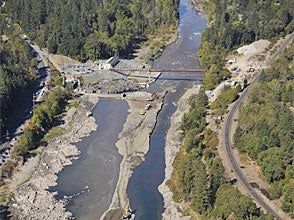Exhilaration As Dam Falls on Rogue River
The Rogue River in Oregon is running free for the first time in 88 years—thanks to Earthjustice. Attorney Mike Sherwood tells how this dam removal is just part of the larger effort to restore salmon and steelhead runs throughout the West Coast.

On October 2, 2009, Earthjustice attorney Mike Sherwood watched as Savage Rapids dam was demolished, allowing the Rogue River to run free for the first time in 88 years. Torn down in large part because of Mike’s legal efforts, the dam was widely regarded as the river’s number one salmon killer.
Here, Mike talks of what it was like to see the fruits of his labors flow by, and he tells how this dam removal is just part of the larger effort to restore salmon and steelhead runs throughout the West Coast.
Describe what you felt as the river again rushed free at Savage Rapids.
Exhilaration and gratification at seeing a real world difference our litigation made. Usually we’re trying to stop harmful actions from taking place; it’s less often that we get a chance to undo a mistake, to take something bad out, to restore something to the way it should be. I felt hopeful for the coho salmon and steelhead that will now be able to get past the dam to their historic spawning grounds, and I couldn’t wait to float the river through where the dam used to be—which I did the next morning.
What was your role in making this happen—how many years did it take?
I was one of the Earthjustice lawyers who represented WaterWatch, the Oregon environmental organization that has been fighting for years to remove Savage Rapids and other dams on the Rogue River, as well as commercial and sport fisher groups, in litigation arguing that by blocking upstream and downstream migration of endangered salmon and steelhead, the dam was “taking” those species in violation of the Endangered Species Act.
That suit took several years and resulted in a settlement whereby the owner of the dam agreed to remove it once new pumps were installed that would pump water for irrigation directly from the river.
But years before that, I had brought a suit against the government that resulted in the coho salmon being placed on the endangered species list in the first place. The second suit wouldn’t have been possible without the first one. Over all, this has been a fight that has lasted about 15 years.
What finally was the turning point in this effort?
Probably when the dam owners realized that they were going to lose the second lawsuit and be found guilty of taking endangered species, a serious federal offense. I think that was the point at which they decided it was in their best interest to seriously discuss settlement.
Other dams are also coming down on the Rogue, right?
Last year, WaterWatch succeeded in getting the Gold Hill dam taken out, and a notch cut in Elk Creek. Efforts are afoot to remove Gold Ray dam. Savage Rapids dam was by far the largest, though, and the biggest fish-killer.
Describe what else you are doing to restore and protect West Coast salmon.
Over the last ten years, our litigation has succeeded in getting the government to declare some 26 species of west coast salmon and steelhead in California, Oregon and Washington to be endangered species, protected by the Endangered Species Act. This is in turn has given us one of the most powerful legal tools available to try to help these fish.
Using the ESA, we were successful in modifying the operations of two of the largest water projects in the world, California’s Central Valley Project and State Water Project, to better protect Sacramento River and Central Valley chinook salmon and steelhead. The new, more protective, operating plans for these water projects that resulted from our earlier litigation have been challenged by large corporate agricultural interests and other commercial water users, so now we are back in court to defend the new plans.
It’s a complicated, politically charged, and seemingly never-ending battle, made all the more difficult by California’s three-year drought.
Up in Washington, our Seattle office is suing to try to get four salmon-killing dams on the lower Snake River removed and generally to improve conditions for salmon in the Columbia River system.